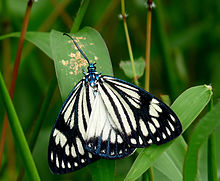Zygaenidae
| Zygaenidae Temporal range:
| |
|---|---|

| |
| Cyclosia papilionaris, female | |
| Scientific classification | |
| Domain: | Eukaryota |
| Kingdom: | Animalia |
| Phylum: | Arthropoda |
| Class: | Insecta |
| Order: | Lepidoptera |
| Superfamily: | Zygaenoidea |
| Family: | Zygaenidae Latreille, 1809 |
| Subfamilies | |

The Zygaenidae
All 43 species of
Description
Larvae
Larvae are stout and may be flattened. A fleshy extension of the thorax covers the head. Most feed on herbaceous plants, but some are tree feeders. Larvae in two subfamilies, Chalcosiinae and Zygaeninae, have cavities in which they store the cyanide, and can excrete it as defensive droplets.[2]
Aposematism in adults
Zygaenid moths are typically day flying with a slow, fluttering flight, and with rather clubbed antennae. They generally have a metallic sheen and often prominent spots of red or yellow. The bright colours are a warning to predators that the moths are distasteful - they contain
However, while the overall picture is of genuine aposematism – the insects are both conspicuously coloured and toxic, containing cyanogenic glucosides – a study by Emmanuelle Briolat and colleagues including Martin Stevens found no evidence of a quantitative relationship between the visual signals of different species of Zygaenidae and their toxicity.[6]
Evolution
The fossil species
Economic importance
The grapeleaf skeletonizer can be a problem in vineyards, feeding on foliage and can also be found feeding on Virginia creeper.
Selected taxa

Genera incertae sedis include:
- Almond-tree leaf skeletonizer moth(Aglaope infausta)
- Vine bud moth(Theresimima ampellophaga)
- Grapeleaf skeletonizer (Harrisina americana)
South European species:
UK species:
- Scarce forester(Jordanita globulariae)
- Cistus forester(Adscita geryon)
- Green forester (Adscita statices)
- Scotch burnet (Zygaena exulans)
- Slender Scotch burnet (Zygaena loti)
- New Forest burnet (Zygaena viciae)
- Six-spot burnet (Zygaena filipendulae)
- Five-spot burnet (Zygaena trifolii)
- Narrow-bordered five-spot burnet(Zygaena lonicerae)
- Transparent burnet(Zygaena purpuralis)
African species:
- Fire grid burnet (Arniocera erythopyga)
Extinct species:
- Neurosymploca? oligocenica Fernández-Rubio & Nel, 2000 (Céreste, Alpes-de-Haute-Provence, France)
See also
References
- ^ Tarmann, G.M. "Zygaenid moths of Australia. A revision of the Australian Zygaenidae".
- ^ Niehuis, O., Yen, S.H., Naumann, C.M. & Misof, B. (2006). "Higher phylogeny of zygaenid moths (Insecta: Lepidoptera) inferred from nuclear and mitochondrial sequence data and the evolution of larval cuticular cavities for chemical defence." Molecular Phylogenetics and Evolution 39(3): 812-829.
- ^ The Lepidoptera: Form, function and diversity. Oxford Univ. Press.
- ^ "Plants And Predators Pick Same Poison - Science News". www.sciencenews.org. Archived from the original on 2011-04-15.
- ^ Naumann, C.M., Tarmann, G.M. & Tremewan, W.G. (1999). The Western Palaearctic Zygaenidae. Apollo Books.
- PMID 30317689.
- ^ Fernández-Rubio, F.; Nel, A. (2000). "Neurosymploca? oligocenica a new fossil species of Lepidoptera Zygaenoidea of the Oligocene of Céreste (Lubéron, France)" (PDF). Boletín de la S.E.A. 27: 7–16.
- PMID 22110404.
External links
- List of Zygaenidae Types, p. 8-11 (Museum Witt München).
- Moths and Butterflies of Europe and North Africa - Zygaenidae - many pictures of species
- "Family Zygaenidae". Insecta.pro. Retrieved February 7, 2020.
- Science News: Zygaenidae "make cyanide using the exact same cellular machinery as their host plants"
- Images of Zygaenidae species in New Zealand
